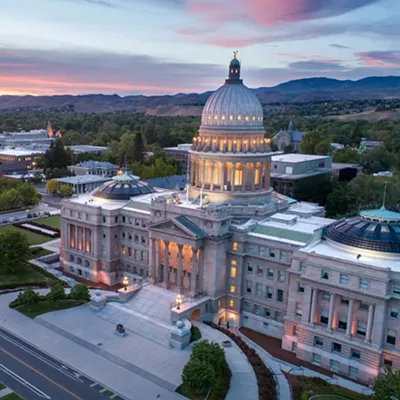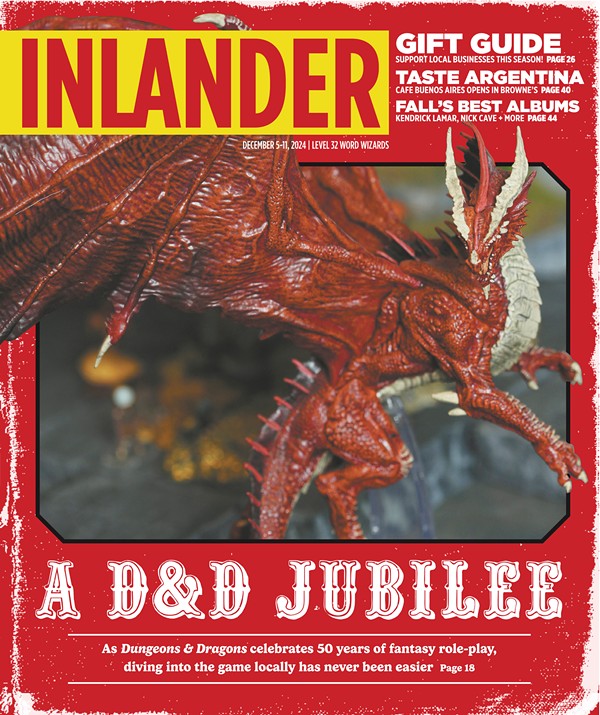History Lives On
[
{
"name": "Broadstreet - Instory",
"component": "25846487",
"insertPoint": "4",
"requiredCountToDisplay": "4"
},{
"name": "Broadstreet - Empower Local",
"component": "27852456",
"insertPoint": "8",
"requiredCountToDisplay": "8"
},{
"name": "Broadstreet - Instory",
"component": "25846487",
"insertPoint": "12",
"requiredCountToDisplay": "12"
},{
"name": "Broadstreet - Instory - 728x90 / 970x250",
"component": "27852677",
"insertPoint": "18",
"requiredCountToDisplay": "18"
},{
"name": "Broadstreet - Instory",
"component": "25846487",
"insertPoint": "5th",
"startingPoint": "23",
"requiredCountToDisplay": "24",
"maxInsertions": 100
}
]
by William Stimson
Fifteen or 20 years ago I read in one of John Fahey's books (I can't even remember which) an explanation of how Spokane became a railroad town. Railroads came through Spokane, Fahey wrote, because "a notch in the mountains" to the east channeled them here. I never forgot that image and I never forgot the idea behind it. It is vintage Fahey: a solid historical insight made absolutely clear by an impeccable choice of words.
Fahey died on July 13, at the age of 84, having devoted half a century to the intense study of this region's past. He started studying Native American history at a time when it was still possible to talk to bearers of oral histories. Ultimately he produced full-length studies of the Flatheads, the Kalispels and the Coeur d'Alenes.
He is also one of the nation's leading historians of mining, having tunneled through mountains of mining records stored at the University of Idaho to produce detailed studies of the development of the Hercules and the Hecla, among other mines.
Fahey's first book was a biography of D.C. Corbin, the buccaneer developer, and his next-to-last book was a biography of Jay P. Graves, who came to Spokane to make a fortune and almost incidentally helped establish Manito Park and Whitworth College. They exhibited, as Fahey said in the Graves book, "that antipodal mix of acquisitiveness and altruism that puzzles later generations."
Fahey believed such men were worth a close look because, "Graves and other men from roughly 1890 to 1930 stamped Spokane with their vision of the kind of city they thought it ought to be." In the closing chapter of an earlier book, The Inland Empire: Unfolding Years 1879-1929 (1986), Fahey described the intertwined social and political system through which these leaders sought to govern by assent. "If their progress toward this consensus ideal," he wrote, "sometimes seemed heavy-handed and self-seeking (as it occasionally was), their outlook was benevolent, and, because elemental Spokane was not complex, they achieved much of what they intended." Fahey was the first local historian to look at Spokane with a critical eye.
But, though he could be critical, Fahey wore his affection for Spokane on his sleeve. The closing words of The Inland Empire are: "True Spokane believers ... listened with parochial impatience to visitors who favored any other city. They savored the ambience of parks, tree-lined avenues, hills, the river, lakes, warm days and cool nights, and leisurely living, and summed up their heritage in a homely truth, 'It's a nice place to live.'"
Aside from the books, he wrote dozens of entertaining magazine and journal articles about the oddities and the flavor of the region's past: "Million Dollar Corner: The Development of Downtown Spokane, 1890-1920"; "When the Dutch Owned Spokane"; "The Brothers Riblet"; "The Longest Crap Game in the West: The Spokane Stock Exchange"; "Spokane's Grand Plan To Pre-empt Coulee Dam." These represent some of Fahey's most lively reading; a collection would make a good 10th volume in his collected works.
In his ninth and final book (Saving the Reservation: Joe Garry and the Battle To Be Indian), finished when he was 80, Fahey drew together the strings of his half-century-long career. The era of white settlement began with a clash between local Indians and Col. Edward Steptoe in 1858, and Fahey's recounting of this scene is a sample of his spare and vivid narrative style: "As the priest [Joset] reined in his mount a confused, swirling battle broke out: whooping Indians dashed close to the fire; troops shot back and strained to control panicked animals. The soldiers began a slow retreat over open, grassy, treeless terrain." Saving the Reservation is mostly about the aftermath of that first clash, the tortuous story of what became of the natives over the ensuing century. Its hero is a modern Indian, Joe Garry, who fought the federal government's efforts to eliminate reservations and with them tribal identity.
A reviewer of Saving the Reservation objected (in a mostly complimentary review) that Fahey had included too many "concurrent resolutions, joint telegrams, and executive committee minutes." This critic managed to criticize exactly what is best about Fahey as a historian of the West: Fahey does not cut to the chase.
There are plenty of dramatic scenes in Western history, and Fahey could render them as well as anyone. But what fascinated him was how life worked in those non-cinematic periods. He saw history as the product of the decisions of ordinary people -- sometimes conscientious, sometimes not -- but real people moved by ambitions, principles, appetites, and fears we can all understand.
Piecing together that kind of story translated into weeks and months of slogging work among dusty letters and ledgers. (Historian Bill Youngs, who had written successful national histories before he wrote The Fair and the Falls, told me once he was surprised at how much harder local history was: No one had prepared the way.) This was made harder by the fact that Fahey never had the leisure of financial independence. Local history, of course, promised little financial reward.
But he stayed at the task for fifty years, and as a result the rest of us know much more about where we are. The chronicler of Spokane's pioneers deserves to be remembered as one of those pioneers.
Books by John Fahey: Inland Empire: D.C. Corbin and Spokane (1965); The Ballyhoo Bonanza: Charles Sweeney and the Idaho Mines (1971); The Flathead Indians (1974); The Days of the Hercules (1978); The Inland Empire: The Unfolding Years 1879-1929 (1986); The Kalispel Indians (1986); Hecla: A Century of Western Mining (1990); Shaping Spokane: Jay P. Graves and His Times (1994); Saving the Reservation: Joe Garry and the Battle To Be Indian (2001)
Publication date: 08/26/04
Fifteen or 20 years ago I read in one of John Fahey's books (I can't even remember which) an explanation of how Spokane became a railroad town. Railroads came through Spokane, Fahey wrote, because "a notch in the mountains" to the east channeled them here. I never forgot that image and I never forgot the idea behind it. It is vintage Fahey: a solid historical insight made absolutely clear by an impeccable choice of words.
Fahey died on July 13, at the age of 84, having devoted half a century to the intense study of this region's past. He started studying Native American history at a time when it was still possible to talk to bearers of oral histories. Ultimately he produced full-length studies of the Flatheads, the Kalispels and the Coeur d'Alenes.
He is also one of the nation's leading historians of mining, having tunneled through mountains of mining records stored at the University of Idaho to produce detailed studies of the development of the Hercules and the Hecla, among other mines.
Fahey's first book was a biography of D.C. Corbin, the buccaneer developer, and his next-to-last book was a biography of Jay P. Graves, who came to Spokane to make a fortune and almost incidentally helped establish Manito Park and Whitworth College. They exhibited, as Fahey said in the Graves book, "that antipodal mix of acquisitiveness and altruism that puzzles later generations."
Fahey believed such men were worth a close look because, "Graves and other men from roughly 1890 to 1930 stamped Spokane with their vision of the kind of city they thought it ought to be." In the closing chapter of an earlier book, The Inland Empire: Unfolding Years 1879-1929 (1986), Fahey described the intertwined social and political system through which these leaders sought to govern by assent. "If their progress toward this consensus ideal," he wrote, "sometimes seemed heavy-handed and self-seeking (as it occasionally was), their outlook was benevolent, and, because elemental Spokane was not complex, they achieved much of what they intended." Fahey was the first local historian to look at Spokane with a critical eye.
But, though he could be critical, Fahey wore his affection for Spokane on his sleeve. The closing words of The Inland Empire are: "True Spokane believers ... listened with parochial impatience to visitors who favored any other city. They savored the ambience of parks, tree-lined avenues, hills, the river, lakes, warm days and cool nights, and leisurely living, and summed up their heritage in a homely truth, 'It's a nice place to live.'"
Aside from the books, he wrote dozens of entertaining magazine and journal articles about the oddities and the flavor of the region's past: "Million Dollar Corner: The Development of Downtown Spokane, 1890-1920"; "When the Dutch Owned Spokane"; "The Brothers Riblet"; "The Longest Crap Game in the West: The Spokane Stock Exchange"; "Spokane's Grand Plan To Pre-empt Coulee Dam." These represent some of Fahey's most lively reading; a collection would make a good 10th volume in his collected works.
In his ninth and final book (Saving the Reservation: Joe Garry and the Battle To Be Indian), finished when he was 80, Fahey drew together the strings of his half-century-long career. The era of white settlement began with a clash between local Indians and Col. Edward Steptoe in 1858, and Fahey's recounting of this scene is a sample of his spare and vivid narrative style: "As the priest [Joset] reined in his mount a confused, swirling battle broke out: whooping Indians dashed close to the fire; troops shot back and strained to control panicked animals. The soldiers began a slow retreat over open, grassy, treeless terrain." Saving the Reservation is mostly about the aftermath of that first clash, the tortuous story of what became of the natives over the ensuing century. Its hero is a modern Indian, Joe Garry, who fought the federal government's efforts to eliminate reservations and with them tribal identity.
A reviewer of Saving the Reservation objected (in a mostly complimentary review) that Fahey had included too many "concurrent resolutions, joint telegrams, and executive committee minutes." This critic managed to criticize exactly what is best about Fahey as a historian of the West: Fahey does not cut to the chase.
There are plenty of dramatic scenes in Western history, and Fahey could render them as well as anyone. But what fascinated him was how life worked in those non-cinematic periods. He saw history as the product of the decisions of ordinary people -- sometimes conscientious, sometimes not -- but real people moved by ambitions, principles, appetites, and fears we can all understand.
Piecing together that kind of story translated into weeks and months of slogging work among dusty letters and ledgers. (Historian Bill Youngs, who had written successful national histories before he wrote The Fair and the Falls, told me once he was surprised at how much harder local history was: No one had prepared the way.) This was made harder by the fact that Fahey never had the leisure of financial independence. Local history, of course, promised little financial reward.
But he stayed at the task for fifty years, and as a result the rest of us know much more about where we are. The chronicler of Spokane's pioneers deserves to be remembered as one of those pioneers.
Books by John Fahey: Inland Empire: D.C. Corbin and Spokane (1965); The Ballyhoo Bonanza: Charles Sweeney and the Idaho Mines (1971); The Flathead Indians (1974); The Days of the Hercules (1978); The Inland Empire: The Unfolding Years 1879-1929 (1986); The Kalispel Indians (1986); Hecla: A Century of Western Mining (1990); Shaping Spokane: Jay P. Graves and His Times (1994); Saving the Reservation: Joe Garry and the Battle To Be Indian (2001)
Publication date: 08/26/04

















